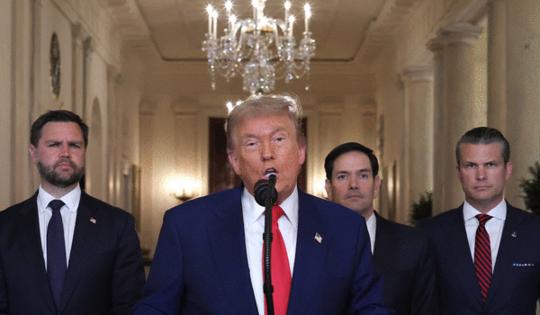Analysis: 'Obliterated': How one word has clouded success of Trump's Iran strikes
Published in News & Features
WASHINGTON — President Donald Trump’s use of the word “obliterated” has ignited a clash with congressional Democrats and the press corps over the military strikes he ordered on Iran and overshadowed a major foreign policy win.
“Completely and totally obliterated.”
“Destroyed.”
“Inoperable.”
“Enormous damage.”
“Completely demolished.”
“Defeated.”
All are descriptors Trump and some of his top aides have used since the president addressed the nation Saturday night after the military strikes on Iranian nuclear targets. The president repeated the “obliterated” assessment at an impromptu news conference Friday to celebrate a handful of favorable Supreme Court rulings.
But the Trump team’s varying use of the word has blurred just how successful the operation was, although there could be little dispute that the audacious undertaking involving B-2 bombers, fighter aircraft escorts and supporting aerial tankers went off without a casualty or operational hitch.
White House and administration officials have used the overall success of the operation to lash out at the press corps and congressional Democrats for asking questions and seeking information to gauge whether Iran’s three main nuclear facilities were permanently “obliterated” or taken offline for some yet-unknown period of time.
From a tactical and strategic standpoint, either outcome could be characterized by the Trump administration as a major victory. But the post-strikes semantic battle that the president and his team have waged threatens to snatch defeat from the jaws of what otherwise would be a sizable and bold victory for them.
An examination of Trump’s descriptions of what’s left of the three Iranian sites showcases how administration officials’ word choice blurs the definition of success for what has come to be known as “Operation Midnight Hammer.”
“The devastating U.S. strike on Fordo destroyed the site’s critical infrastructure and rendered the enrichment facility totally inoperable,” Trump said Wednesday at the NATO summit in the Netherlands, reading, in part, from a letter from Israel’s Atomic Energy Commission. “It was devastated.
“We assessed that the American strikes on Iran’s nuclear facilities has set back Iran’s ability to develop nuclear weapons for many years to come,” Trump continued, still reading from the missive. “This achievement can continue indefinitely if Iran does not get access to nuclear material, which it won’t.”
No longer reading, Trump added, “It’s so, so sad that that whole thing had to go.”
But whether the deeply buried Fordo nuclear site did indeed “go” remains unclear.
Moments later, Trump said in reference to a preliminary damage assessment crafted by the Pentagon’s Defense Intelligence Agency: “It could be very severe damage… They said it could be limited or it could be very severe. They really didn’t know, other than to say it could be limited or it could be very, very severe.”
And before that, the president and other administration officials had dismissed that early assessment, calling it too premature as more information was being gathered.
At a contentious Thursday morning news conference at the Pentagon, Defense Secretary Pete Hegseth slammed the press corps for reporting on the early intelligence assessment — which found less than an “obliterated” Fordo, at least at first look.
“You want to call it ‘destroyed,’ you want to call it ‘defeated,’ you want to call it ‘obliterated,’ choose your words. … This was a historically successful attack,” he said, before later adding, “Anyone with … two eyes, some ears and a brain can recognize that kind of firepower, with that specificity, at that location and others is going to have a devastating effect.”
Trump called the sites “completely and totally obliterated” in his Saturday night address, immediately setting the bar for mission success at the Fordo facility that had been turned to rubble inside a dense mountain range in northwestern Iran. But by Wednesday, it seemed the president and other officials were using “obliterated” and other lesser descriptors such as “enormous damage” and “defeated” interchangeably.
At the NATO summit on Wednesday, Hegseth hedged a bit, saying, “We believe, far more likely, ‘severe and obliterated.’”
But at a White House briefing on Thursday, press secretary Karoline Leavitt told reporters that the three Iranian facilities suffered “total obliteration” and were “completely demolished.”
White House and National Security Council officials did not respond to multiple inquires about whether Trump, who has a history of using grandiose language, has been using words like “obliterated” and “inoperable” interchangeably.
Some senior Democrats with seats on congressional national security committees, however, did weigh in to criticize the president’s word choice.
“The Trump Admin. is unwise to prematurely insist Iran’s nuclear program was ‘obliterated’ without clear evidence. This exaggerated claim is unnecessary & could weaken our future credibility & leverage against Iran. Americans deserve facts, not bluster,” Senate Armed Services ranking member Jack Reed of Rhode Island wrote on X.
White House and National Security Council officials also did not respond to a separate inquiry asking how the president and other administration officials could declare that Fordo and the other sites were “obliterated” while simultaneously criticizing the intelligence product as an early assessment made too soon to be considered definitive.
As Trump officials have noted this week to discredit the early intelligence findings, conducting what the military calls a “battle damage assessment” and the task of collecting and analyzing intelligence is very methodical work.
Hegseth said Thursday that the “CIA continues to collect additional reliably sourced information to keep appropriate decision-makers fully informed.”
“John Ratcliffe, the director of the CIA, (put) out a statement just last night: ‘CIA can confirm that a body of credible intelligence indicates Iran’s nuclear program has been severely damaged by recent targeted strikes,’” Hegseth said, citing the Ratcliffe missive.
‘Brightest explosion’
Former California Rep. Jane Harman, who served as the top Democrat on the House Intelligence Committee, told NewsNation on Wednesday that “‘obliterated’ isn’t an intelligence term.”
The current ranking Democrat on that panel, Connecticut Rep. Jim Himes, wrote on X: “All this caterwauling about whether the Iranian nuclear sites were ‘obliterated’ or not completely misses the point. The only question that matters is whether the Iranian regime has the stuff necessary to build a bomb, and if so, how fast.”
Himes added, “So the smart questions are: 1) Did the regime move or retain the uranium? 2) Did they move or retain centrifuges? 3) Did they preserve the metallurgy and other engineering required to build a bomb? 4) If yes, is all that stuff at an unknown location? If the answer to these questions is yes, it’s possible that Iran’s nuclear program was barely set back.”
U.S. officials had no evidence prior to last weekend’s strikes that any uranium had been moved out of the three sites, Leavitt said Thursday.
But hours prior, Hegseth and Joint Chiefs Chairman Dan Caine deflected questions about whether such material had been removed last week. At one point during the Pentagon briefing, the Air Force general whom Trump calls “Razin’ Caine” offered the flash of the explosion over Fordo as definitive proof that the facility was totally wiped out.
“We know that the trailing jets saw the first weapons function, and the pilots stated, ‘This was the brightest explosion that I’ve ever seen. It literally looked like daylight.’”
But Himes contended that fiery clouds alone proved little about the state of the Fordo nuclear facility.
“Our military is truly astonishing. But the goal was not to fly 36 hours and cause big explosions in precise locations,” Himes wrote. “Those were the means. The goal was to end the Iranian nuclear program. And it is far from clear that that was accomplished.”
That could be a reason why, multiple times this week, White House and administration officials have preferred to criticize the media and target leakers, or even push conspiracy theories.
“I do believe there’s an effort on the outside of this building,” Leavitt said Thursday, “to try to divide the president’s team on the inside.”
_____
©2025 CQ-Roll Call, Inc., All Rights Reserved. Visit cqrollcall.com. Distributed by Tribune Content Agency, LLC.







Comments